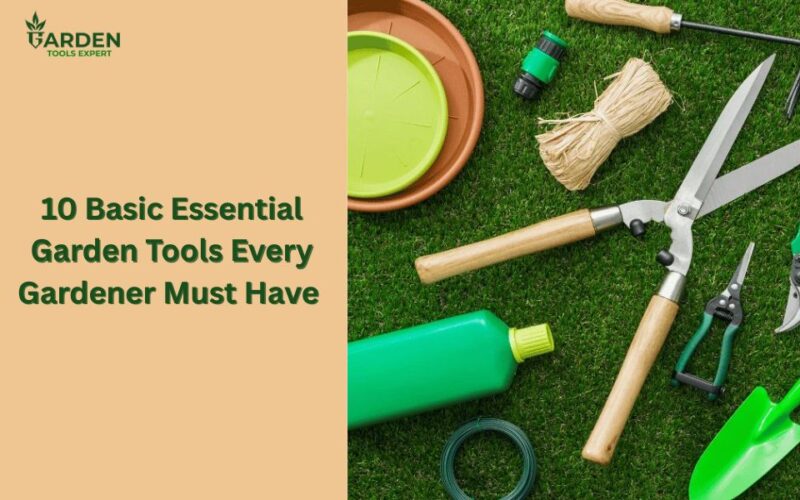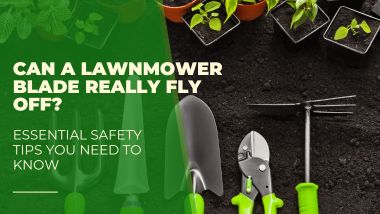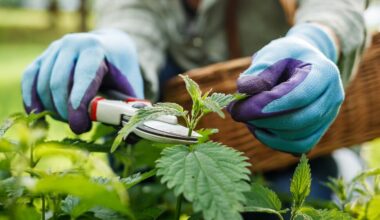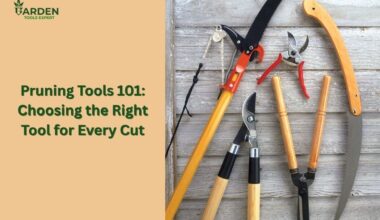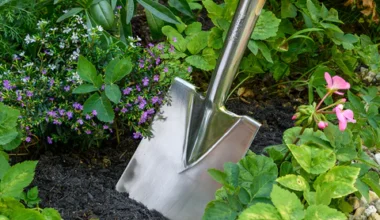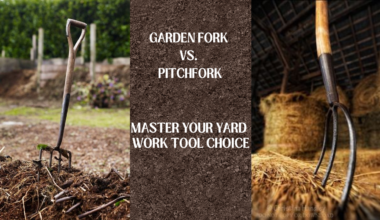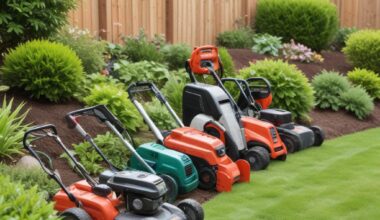Sigh!! halfway through a task and realizing you’re missing the one tool that could make the task easy?
We’ve all been there, digging with the wrong tool, improvising with something that almost works, and even ignoring the struggle just to get the task completed.
The truth is, you don’t need all the tools in the world, but some basic essential tools that will make your gardening journey easy.
Every great garden starts with the right gear. In this post, we’re covering the 10 basic tools every gardener must have in 2025.
1. Gloves
Gardening is a rewarding hobby, but without the right gloves, it can quickly become a painful experience filled with thorns, splinters, and blisters
Gloves are one of the basic essential garden tools every gardener must have
Choosing garden gloves that are durable yet flexible enough for delicate tasks like seeding or transplanting can easily change your mood in a blink
A proper fit is essential; ill-fitting gloves can slip off or cause discomfort during extended use.
Look for water-resistant fabrics that also offer breathability to keep your hands cool and dry. Longer cuffs provide added protection for wrists and forearms, shielding them from scratches and preventing dirt from getting inside.
2. Pruning Shears
Hand pruners, also known as secateurs, are one of the essential tools that help control plants that are getting out of control and taking over.
Anvil-style pruners cut with a sharp blade meeting a flat surface, similar to a knife on a board.
Bypass pruners cut with a sharp blade that passes by a sharp-edged flat surface, similar to scissors.
- Anvil pruners are better suited for removing dead wood, but can cause crush injuries to fresh, green stems and branches.
- Pruners should fit easily in the palm of your hand.
- Ratcheting pruners offer increased cutting strength, making them ideal for individuals with reduced hand strength or arthritis.
Tip: For cleaner cuts and less injury to plants, pruners should be sharpened regularly. It gives you the best cutting tool experience.
3. Hoe
Your type of garden will dictate what type of hoe is best for you. A veggie garden may require a sturdy, wide hoe to effectively break up soil and turn over large patches of earth.
These hoes, often referred to as “broad hoes,” are garden tools designed to cover more ground and can help you prepare your planting beds efficiently.
In contrast, if you have a flower garden or a smaller, more intricate layout, a smaller hoe, such as a “draw hoe” or “scuffle hoe,” may be more suitable.
These types allow for greater precision and control, making it easier to navigate between delicate plants without disturbing their roots.
Additionally, consider the type of soil you will be working with. Sandy soils may require different tools than clay-heavy soils.
For example, a hoe with a sharp edge will be more effective in tough, compacted soil, whereas a wider, flatter blade can be beneficial for digging and leveling sandy or loamy soils.
Ultimately, the right hoe can make a significant difference in the efficiency and effectiveness of your gardening tasks. Take the time to assess your garden’s specific needs, and choose a hoe that will help you achieve the best results for your plants.
If you have perennial gardens, a more delicate touch and a thinner hoe may be required to maintain your garden. Hoes are useful in preparing garden and flower beds and cutting down weeds. This tool is one of the basic essential garden tools you must have because it is multi-purpose.
- Look for a comfortable handle with a long reach.
- A sharp blade works better and is easier to use.
- Weeding hoes, also called hula or stirrup hoes, have an open square head and are pushed back and forth just under the soil surface to cut down top growth.
- Flat hoes are good for turning the soil in rows in vegetable gardens.
4. Loppers
Loppers is one of the basic garden tools every gardener must have
Loppers are long-handled pruners used to trim hard-to-reach areas and cut thicker branches. The long handles provide the leverage it takes to cut through branches up to an inch or more in diameter. There are anvil and bypass types, just like pruners. Handles generally range from 16 to 36 inches.
- Loppers are more precise in cut location than anvil loppers.
- Longer-handled loppers can be heavy. Know what you’ll be cutting and how far you’ll need to reach, and get the appropriate length.
- Lightweight aluminum or carbon-composite handles can be lighter.
- Like pruners, keep lopper blades in good condition and sharpen them regularly.
5. Adjustable Strimmer Shoulder Strap
An adjustable strimmer shoulder S-Com is among the basic essential garden tools that provide an excellent solution for maintaining your lawn, helping you collect leaves and trim edges with ease.
This item offers a variety of features, including an integrated aerator attachment, which allows you to spread nutrients evenly across your garden, ensuring that your plants flourish.
By using this garden tool, you can avoid damaging your lawn while ensuring that it remains healthy and vibrant.
6. Garden Fork
A garden fork is an efficient garden tool for turning soil. They can dig into dense soil better than a spade.
The best garden fork gives you great gardening experiences
Forks with a slight curve to the spines are useful for scooping mulch or turning compost piles, much like a pitchfork.
Straight tines are better suited for digging and work well in compacted, rocky, or clay soil.
Square tines are stronger than flat tines, which can bend when they hit a rock or root. A garden fork, like other digging tools, makes digging easier.
7. Hand Trowel
Trowels are wonderful for transplanting bedding plants and herbs, planting containers, and taking out weeds.
It works well when selecting a broad blade to move more soil or a long, narrow blade to dig up weeds or for rocky soil.
- The handle should fit comfortably in your hand.
- Trowels forged from stainless steel, or at least with a stainless steel head, are more durable and will last longer.
8. A Hori Hori Knife
The multi-functional Hori Hori knife is a precision-crafted garden tool engineered to handle a wide range of soil-related tasks with ease and efficiency.
Its robust, stainless steel blade features a dual edge, one side serrated for cutting through roots and tough weeds, the other smooth for slicing and digging.
Designed to create clean planting holes or slice through compacted earth, this tool allows gardeners to work with accuracy and control, even in tight spaces.
With depth markings etched into the blade, the hori hori ensures consistent planting and minimal disruption to surrounding soil and plants.
Its ergonomic handle and durable construction make it a trusted companion for tasks ranging from weeding and transplanting to measuring and cutting across gardens, flower beds, and even rugged outdoor landscapes
9. Watering Can
There are 2 basic types of watering cans: plastic and metal. There are hundreds of watering tools with different styles, colors, sizes, and nozzle options.
- Plastic cans can be lighter than metal, but they won’t last as long.
- Metal cans should be galvanized to resist rusting.
- Consider the size of the can relative to your strength; a gallon of water weighs just over 8 pounds.
- The handle position should allow you to carry a full can and also tip it to pour easily.
- Two-handled designs allow for better stability for children or elderly gardeners.
- You may need two: a larger one with a sprinkler head for outdoor use and a smaller, long-necked version for indoor houseplants.
A watering can is a must-have basic essential gardening tool because when seasons switch up, the best way to protect your garden is to water it.
10. Wheelbarrow
If your backyard has extra soil to be moved around, compost or mulch that needs to be added to garden beds, or any other heavy lifting and moving project, a wheelbarrow can help you haul hundreds of pounds!
Ace Hardware wheelbarrows and many other wheelbarrows exist to ease your gardening stress.
- Traditional dual-handle, single-wheel styles can be harder to balance heavy or unevenly distributed loads.
- Single-handle two-wheel models are easier to balance and better for those with limited strength or when pulling over uneven terrain.
- Single-handled wheelbarrows can be pushed or pulled with one hand.
- Keep the wheels inflated properly for easier wheeling.
The type of wheelbarrow you choose determines your experience
Conclusion
In the end, when you ask the question, “Do you need these basic essential gardening tools?” the answer is yes! They exist and serve the purpose of making your garden more aesthetically pleasing and do so super efficiently.

